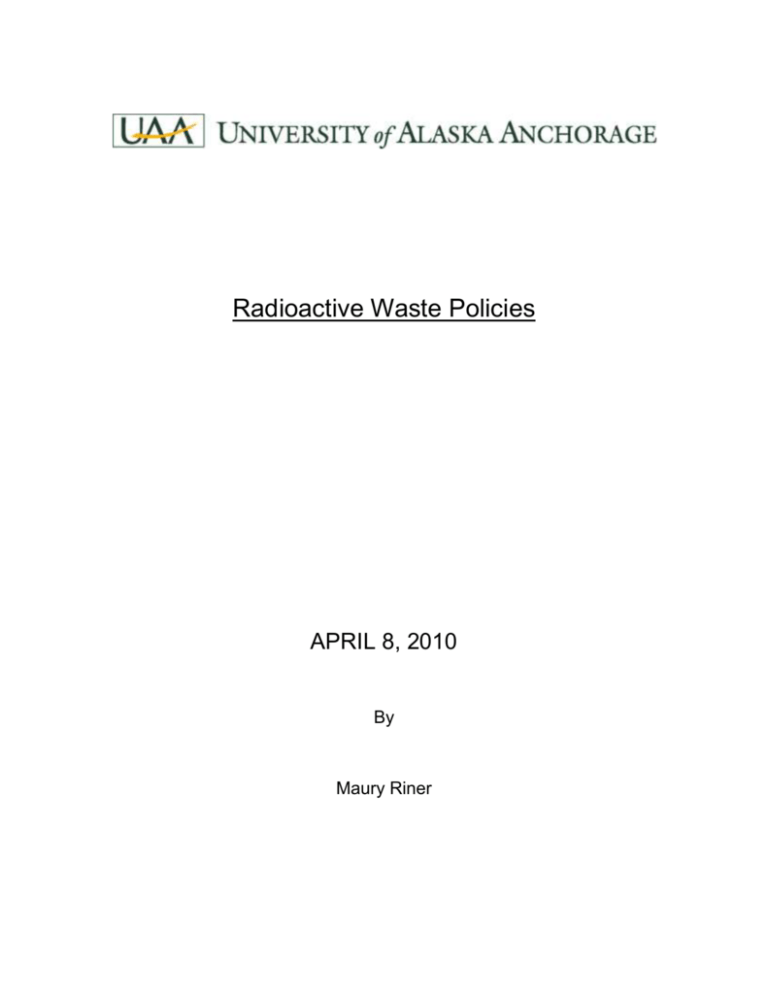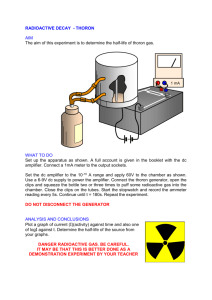Radioactive Waste Policies - University of Alaska Anchorage
advertisement

Radioactive Waste Policies APRIL 8, 2010 By Maury Riner TABLE OF CONTENTS 1. Purpose 1 2. Scope 1 3. Radioactive Waste Classification 1 3.1 Waste Definitions 2 1. Solid Waste 2 2. Liquid Waste 2 a. Aqueous 2 b. Mixed 2 3.2 4. 5. Mixed Waste Examples 2 1. Toxicity 2 2. Corrosivity 2 3. Reactive (Oxidizers) 2 4. Toxicity 2 5. Ignitability / Corrosivity 2 Waste Segregation Procedures 3 4.1 Liquid Radioactive Waste 3 4.2 Mixed Radioactive Waste 3 4.3 Long lived Isotopes 3H,14C 3 4.4 Scintillation Vials and Animal Carcasses 3 Waste Storage Procedures 3 5.1 Aqueous Waste 3 5.2 Mixed Waste (Liquid) 3 6. Waste SOP Requirements 4 7. Waste Disposal Requirements 4 7.1 Aqueous Waste 4 7.2 Solid Waste 5 7.3 Mixed Waste 5 7.4 Sharps Waste 5 8. Waste Disposal Costs 5 8.1 5 Cost Determination LIST OF ABBREVIATIONS 1. Chemical Hygiene Plan (CHP) 2. University of Alaska Anchorage (UAA) 3. Environmental Health Safety & Risk Management Support (EHS / RMS) 4. Occupational Safety and Health Administration (OSHA) 5. Environmental Protection Agency (EPA) 6. Dept. of Environmental Conservation (DEC) 7. Municipality of Anchorage (MOA) 8. Nuclear Regulatory Commission (NRC) 9. Principal Investigators (PIs) 10. Research Lab Supervisors (RLS) 11. Radiation Safety Officer (RSO) 1. PURPOSE While the Chemical Hygiene Plan (CHP) for the University of Alaska Anchorage provides written guidelines regarding university, faculty, employee and student responsibilities while using hazardous chemicals in their quest for knowledge in the teaching and research laboratories. Safe and effective research requires attention to all responsibilities / obligations that the Principle Investigator (PI) / Research Lab Supervisors (RLS) have to the university, research sponsors and most importantly to those employees, student researchers, visiting research professionals working in any research laboratory at (UAA) and all other residing occupants of those buildings where research is conducted. These responsibilities start with those given in sections 4.23 and 10.3 of the UAA Chemical Hygiene Plan. This document provides additional policies / guide lines regarding the use of radioactive materials and the management of radioactive waste for all research laboratories at (UAA) under the current NRC license, CESQG status, and any other federal, state or municipal requirements. 2. SCOPE The policies / guidelines developed here cover all internal and externally funded research projects by faculty, employee, student, and visiting research professionals undertaken at the University of Alaska or satellite campuses that purchase / use radioactive labeled markers, specific radioactive isotopes, instrumentation that incorporate sealed sources and any process that produces / or generates radioactive waste through the use of these products. In addition any consumable supplies such as sharps, syringes, or pieces of equipment that has been contaminated with or used in conjunction with any of those aforementioned radioactive materials shall be considered radioactive waste. 3. RADIOACTIVE WASTE CLASSIFICATION Radioactive waste shall include any dry solid waste, aqueous waste and mixed waste stemming from the use of those aforementioned radioactive materials. The Principle Investigator (PI) / Research Lab Supervisors (RLS) of each lab using any radioactive materials are responsible for determining if the waste generated during their course of research would be classified as aqueous or mixed based on the methodology in use. Please consult with the RSO and EHS / RMS if the laboratory has any questions on waste classification. Additional information about waste classifications will be given in the definition section. 3.1 3.2 WASTE DEFINITIONS 1. Solid Waste: Solid waste refers to those materials that are insoluble or solids left over after extractions such as bone, hair, tissue including plant or other biological solids resulting from research procedures. Solid waste also includes items such as pipette tips, micro centrifuge tubes, scintillation vials, sharps, gloves and other debris. 2. Liquid Waste: While liquid radioactive waste can contain many components it must be homogeneous and pourable. Liquid waste shall be classified into two categories depending on the components of the waste, either water or aqueous based and mixed based. (a) Aqueous Waste: Aqueous waste refers to liquid radioactive waste that consists mainly of radioactive materials dissolved in non-hazardous water solution. This solution MUST NOT contain any HAZARDOUS CHEMICALS. (b) Mixed Waste: Mixed waste refers to liquid radioactive waste that contains both radioactive materials and hazardous chemicals. Hazardous chemicals are those having any one of the following characteristics of corrosivity, ignitability, reactivity and toxicity as outlined in 40 CFR Part 261 and defined by the EPA. MIXED WASTE EXAMPLES 1. 32P 2. 14C 3. Thorium Nitrate / Uranyl Nitrate fall under reactive (oxidizers) characteristics 4. Uranyl Acetate radioactive solid falls under toxicity characteristics 5. Even though 18O is not a radioactive isotope 18O labeled acetic acid in ethyl acetate falls under ignitability / corrosivity characteristics. 6. Tritium in phenol in chloroform falls under corrosivity / toxicity characteristics. labeled GTP in chloroform falls under toxicity characteristics labeled acetic acid falls under corrosivity characteristics 4. 5. WASTE SEGREGRATION PROCEDURES 4.1 All liquid radioactive waste must be first segregated based on chemical composition (aqueous or mixed*) and secondly by radioactive isotope. If mixed see section 4.2 for additional rules. 4.2 All mixed radioactive waste must be first segregated by hazardous characteristics of the waste (corrosivity, ignitability, reactivity, toxicity), and secondly by radioactive isotope. Chemical compatibility may also need to be considered as a third point of segregation for mixed radioactive wastes. 4.3 All radioactive waste containing long lived isotopes like 3H, 14C should be segregated from those isotopes with half-lives < 120 days. Every different elemental isotope type must be have its own segregated waste container do not mix isotopes of differing elements. 4.4 Scintillation vials, fluid and animal carcasses containing < 0.05 μCi/g of 3H, 14C are currently exempt when no other (chemical / biohazards) are present. WASTE STORAGE PROCEDURES 5.1 Aqueous Waste Many aqueous wastes qualify for sewer disposal from the radiation safety perspective. See the section 7.1 on waste disposal for these requirements or contact the RSO and EHS / RMS. 5.2 Mixed Waste (liquid) All mixed waste must be stored in the lab responsible for the waste generation. RSO will collect labeled waste containers when are 80 % full. Important guide lines to remember are: 1. Remember proper segregation rules 2. Waste container must be closed at all times except when adding waste. 3. All waste containers must have secondary containment capable of holding the total volume of waste liquid in the original waste container in the advent of a container failure or spill. 4. When moving or transporting the material the container lid must be fully closed and secondary containment vessel (rubber boot) must be used. 5. Do not place solid waste items such as pipette tips, micro centrifuge tubes, scintillation vials, sharps, gloves and other debris in with the mixed waste. 6. All waste containers must be labeled with the appropriate radiation activity and chemical hazard warnings. 7. All sharps waste must be in puncture proof containers and will labeled with the appropriate radiation activity and chemical hazard warnings. 6. WASTE SOP REQUIREMENTS When any Principle Investigator (PI) / Research Lab Supervisors (RLS) is planning any experiment or research project that will generate mixed waste a written standard operating procedure (SOP) is required. This (SOP) should include all information regarding collection, storage, labeling and disposal of mixed waste, estimated quantity and type of mixed waste generated, and an explicit drawing showing the area of use along with contamination prevention procedures. In those cases when using particularly or acutely hazardous or OSHA regulated substances a substance specific (SOP) may be required along with the standard (SOP). Questions and help with these matters are available by contacting the (RSO) and (EHS / RMS). 7. WASTE DISPOSAL REQUIREMENTS 7.1 Aqueous Waste For sewer disposal aqueous waste must meet all of the following requirements outlined below. 1. Soluble in water or dispersible biological material. 2. Not above concentration limits, averaged monthly, see RSO 3. Not above quantity limits 5 Ci/yr 3H, 1 Ci/yr 14C and 1 Ci/yr all other aqueous waste combined. 4. Detailed records regarding date, volume, concentration, quantity and responsible person for disposal must be kept. 7.2 Solid Waste Solid waste will qualify for decay in storage as long as the half life is ≤ 120 days. After a sufficient decay period RSO will assay solid waste for any radioactivity. When the radioactivity level is below background levels the waste will be properly disposed of. 7.3 Mixed Waste Mixed waste will be reduced in volume by the generator so as to permit short term storage. Technically there is no long term storage or indefinite storage of RAM waste. 7.4 Sharps Waste Sharps waste shall be placed into an appropriately labeled puncture resistant container. Sharps waste will not be mixed with other radioactive waste materials. 8. WASTE DISPOSAL COSTS 8.1 Cost Determination Any costs associated with the proper disposal of all non-sinkable radioactive waste, or mixed radioactive waste will be charged to the department or college level authority of the user that ordered the radioactive material or generated the radioactive waste.






